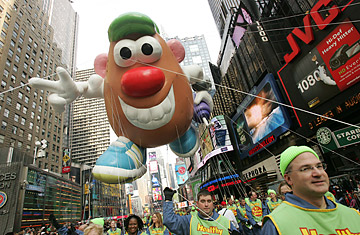
The Mr. Potato Head balloon floats during the 81st annual Macy's Thanksgiving Day Parade.
On Thanksgiving morning, after the turkeys are safely in the oven but before the green bean casserole preparations begin, Santa Claus will travel 2.5 miles down the streets of Manhattan — from 77th Street to Macy's department store at 34th Street — riding high atop his first new sleigh in over 40 years as the key figure in Macy's Thanksgiving Day Parade.
3.5 million people will crowd the streets for the parade's 83rd annual run, while another 50 million households will watch from home. Twenty-four floats; 15 helium character balloons (including four new ones); and hundreds of clowns, acrobats and cheerleaders will accompany Santa as he greets onlookers from his new, 3-story sleigh.
The first parade was a much smaller procession, created in 1924 by Macy's employees eager to celebrate Christmas ( that's right, it used to be a Christmas parade) and draw attention to their department store. The employees marched six miles, from Harlem to Herald's Square, dressed as clowns, knights and cowboys. Marching bands and animals from the Central Park Zoo accompanied the parade's first floats: The Old Lady Who Lived in a Shoe, Miss Muffet and Red Riding Hood. The event attracted a quarter of a million people and was deemed a roaring success. Macy's decided to make it an annual event.
In 1927, Felix the Cat became the first official parade balloon. Macy's filled the rubber animal with helium but didn't have a plan for deflating it when the parade was done, so Felix was just released into the air. He popped, of course, so the next year officials released balloons again, but incorporated release valves designed to let the helium leak out slowly over the course of a week. The balloons' release received much publicity; Macy's claimed that they would float hundreds of miles away from New York before landing softly in fields or people's yards. Stitched into balloons was a return address, and those who found one could return it to Macy's for a $100 reward. Unfortunately their flights weren't so peaceful. Out of five balloons, three landed in Long Island (one was torn to pieces by neighbors competing for the prize), one drifted into the East River, and one floated out to sea never to return. Stubbornly, Macy's tried the balloon release again, but in 1932 an errant balloon wrapped itself around a passing airplane's wing, sending it into a tailspin. The balloon release plan was abandoned in 1933, the same year that parade attendance hit one million.
Most balloon characters take the form of recent popular comics or cartoons, such as Underdog (1965), Kermit the Frog (1977), Barney (1994). Walt Disney got in on the action in 1934, with the first Mickey and Minnie Mouse balloons. But the character with the most balloons has been Snoopy. Charles Schultz' floppy-eared mutt has gone through six balloon changes since his debut in 1968.
Floats were pulled by horses until 1939, when NBC broadcast the parade for the first time. The parade was suspended between 1942-1944 when the balloons were recycled into 650 lbs. of rubber and donated to the war effort. New Yorkers were so overjoyed by the return of the parade in 1945 that over 2 million people turned out for the event.
Winter weather can be unpredictable, and the Macy's parade has had its share of mishaps. Crosswinds hit balloons when they pass through intersections — Times Square is especially tricky — and can blow them off course. In 1928, a giant dog balloon escaped from its handlers, blew against a street sign and deflated. The same thing happened in 1956, when Mighty Mouse failed to save the day and collapsed instead. Heavy rain filled the brim of Donald Duck's hat in 1962, causing the character to tip over and dump 50 gallons of water on unamused onlookers. In 1971, rain fell so heavily that the balloon portion of the parade was cancelled. Sonic the Hedgehog broke an off-duty policeman's shoulder in 1993, but the worst accident came in 1997, when 43-mph winds blew The Cat in the Hat into a lamppost, causing the metal arm to fall off and hit 33-year-old Kathleen Caronna on the head. Caronna spent nearly a month in a coma, then sued Macy's and the city for $395 million. (The parties reached an undisclosed settlement in 2001.) Nine years later, in a strange twist of "only in New York" fate, Yankee relief pitcher Cory Lidle crashed his private airplane into Caronna's highrise apartment.
The 2009 Macy's Thanksgiving Day Parade should be much more subdued — although it is scheduled to rain — and the new regulations implemented by city officials in 1998 have minimized the possibility of a balloon rampage. Accidents are still possible, of course. Remember that crazed airborne M&M that tore apart a lamppost in 2005?
